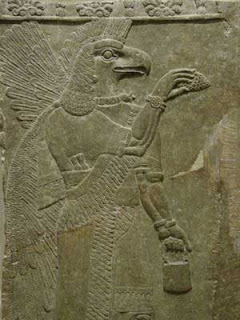Good Morning... The coffee is hot, the dog is fed, and the shapes of life are emerging from the darkness outside my window. Down to work...
A couple days ago I wrote how I felt my working drawing for this project would make a suitable painting, and until recently I would have continued along with that train of thought. But now I want to say more, to explore painting more fully. But, what does that mean? Maybe it means nothing to the casual viewer of my work, personally it is akin to a paradigm shift in my head. My goal with this project is to let the paint lead me, to allow the image to come from within itself.
If Art is a language, I'm trying out a new dialect.
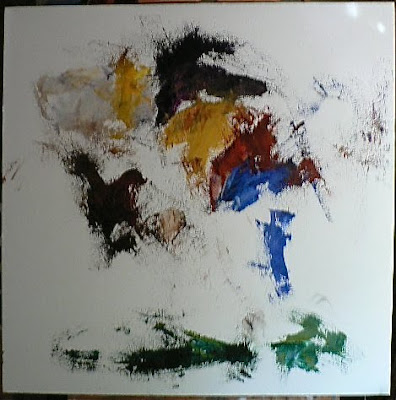
Looking at this canvas, I quite possibly just lost half of any audience I've ever had.
Many who look at Art never consider its beginnings, they simply assume that all of the colors flow out of the artiste's hand in one long deft swaying stroke, like Jack Frost painting the leaves in Disney's 'Fantasia'. I speak from experience because I believed it too. (As a side note, I LOVED that movie as a kid!! That scene where the ice is painted on the whole forest by the mere touch of a brush. I was there!)
Reality check. NOT how it happens!Ya gotta start somewhere, and at first it ain't always a pretty picture. However, this isn't to say there is no structure. From the first grasp of the stretcher bar I have imaged my idea, looked at the surface, plotted and designed a course of action for applying paint to the surface. I decided which areas will come forward and which will recede, where I will want glazes, where will the paint be more impasto, and where I'll allow the surface itself to speak.
Looking at the canvas after the first day of actually painting, yes, it is rough; but there is a lot to look forward to. For instance, notice how the unpainted shapes form the base of the central shape seated firmly along the bottom. Above, the depth of the atmosphere is emerging in the dark browns and rusty blues. At this point, I'm doing two things at once, pushing back into space with the dark colors and pulling forward with the lighter. These areas will become underpainting for what is to come. Underpainting is the first layers of paint on a canvas, setting the tone and blocking in mass. In this case, I've used negative space almost as much as I've used paint to define much of the central mass. Negative space is the area around a figure and can be thought of as the air around a mass.
I take for granted how I work, so it is difficult for me to step back and actually look at what I do and describe it. It's funny to think how much information can be described with a video or a simple picture.
A picture truly is worth a thousand words. As a thought exercise, try to describe getting dressed in the morning to a lifelong nudist, someone who's never worn clothes!
To this point all the paint on the canvas has been
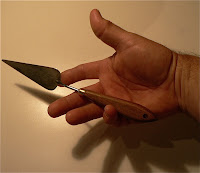
applied with a palette knife (my favorite one is in my hand to the right). I usually start a painting with a knife, sometimes I draw-in shapes using oil sticks (fat oil paint crayons). Also, I use a hand held palette (that's my palette on the right). I don't like to premix my paint, I like to apply pure color to the canvas; sometimes I squeeze the paint out directly from tube to canvas. For me this process seems to keep my paint from getting muddy. Also I don't
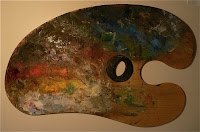
really use any medium, just turpenoid, the finish with medium is too shiny.
These may seem tedious points to bring up, but as an artist they are absolutely essential things to know. As a young artist, I was voracious in pursuit of information on how to do everything. To that end I became an avid reader of artist biographies, looking

for any little glint of information on how others actually make their work. The pursuit never ends, just last week I watched a video of Agnes Martin,
With My Back To The World. It was so enlightening watching her apply paint, how she held a brush in her hand, chasing paint drops down the canvas with the tip of her brush, and the fact that she didn't like to talk while she painted! It was so refreshing to see an artist so open to share herself. I don't see why artists are so secretive
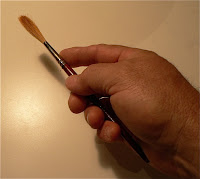
about how they work, it's just silly.
I used to paint exclusively holding my brush as you would write (that curious way that tightens up your shoulder), it is much more freeing to hold the brush as you would hold a piece of charcoal for gesture drawing (drawing from the figure very quickly). One of the conscious decisions I made with my painting recently is to hold my brush in this manner.
Note: I realize these are water color brushes I'm showing, but I really like painting with them, and until I can get to New York to find the long bristle brushes like DeKooning used, I'll have to settle.
I am not purporting here that I know it all, but I do know what works for me. It may not be the correct way; some ways may work better or faster, but possibly the way you or I make Art, that more difficult way, produces just the spark that makes the work special. I cannot help but feel that by seeing how others work helps us validate that what we are doing is alright, and quite possibly to learn something new.
A wise person once told me there really is no correct way to make Art.
Paint well...






